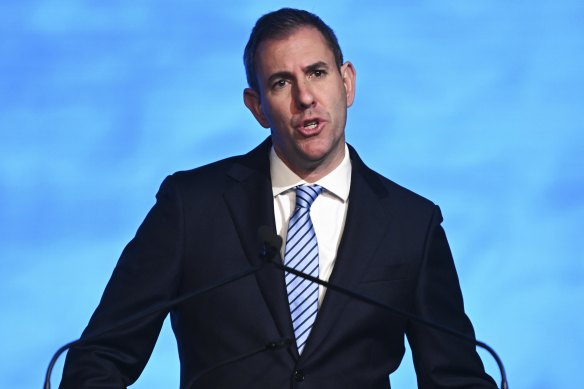This was published 7 months ago
When it comes to cost-of-living pressures, there is one group being hit hardest
By Millie Muroi and Shane Wright
The real cost of living is growing at almost double the inflation rate for millions of working families as their soaring mortgages and high insurance premiums wipe out the benefits of higher wages, tax cuts and government handouts.
As Treasurer Jim Chalmers rejected suggestions that government spending was adding to inflation and forcing the Reserve Bank to consider an interest rate hike, figures from the Australian Bureau of Statistics showed the cost-of-living increase for working households eased to 6.2 per cent for the year to June.
By contrast, the headline inflation rate was 3.8 per cent in June.
Mortgage interest charges – which are not included in the official Consumer Price Index inflation gauge – were a key component in the cost-of-living measure for working families, soaring 26.5 per cent over the year as mortgage debt levels increased, and more fixed-rate loans rolled onto higher variable rates.
Insurance costs for working households have climbed by 15.4 per cent over the past year, and have been above the official measure of inflation for three consecutive years.
It comes as Reserve Bank governor Michele Bullock on Tuesday killed off hopes of a pre-Christmas interest rate cut. On Wednesday, RBA assistant economic governor Sarah Hunter, appearing before the Senate select committee on cost of living, said different groups were having varied experiences.
“We’re aware that for some people right now, and for some businesses as well, it’s really tough,” she said. “We know some people have had to squeeze themselves very, very hard to get by.”
Age pensioners and self-funded retirees saw the smallest increases in their cost of living at 3.7 per cent and 3.8 per cent, respectively. The quarterly increase of 1.2 per cent for self-funded retirees was due to higher international holiday travel and accommodation prices amid an increase in demand for holiday travel to Europe, the bureau said.
Hunter said the bureau had re-evaluated people’s travel habits and found there was a “bit more spending overseas” than previously thought.
At the same time, medical, dental and hospital services, which comprise a large proportion of spending for this group, also rose in the June quarter, reflecting an increase in health insurance premiums in April.
Pensioners faced a 4.1 per cent rise in cost of living, while other welfare recipients recorded a 4.6 per cent increase, and the strongest quarterly rise, due to increases in rents and electricity costs as energy rebates were used up.
Treasurer Jim Chalmers, speaking on ABC Radio National on Wednesday morning, refuted claims the energy rebates had limited success in pushing down inflation.
“What the ABS has shown in recent inflation data is that the way we’re delivering our cost-of-living relief is putting downward pressure on inflation,” he said. “The Reserve Bank’s near-term inflation forecasts are better, not worse.”
Deputy Opposition Leader Sussan Ley said Australians could expect a “tough Christmas”.

Treasurer Jim Chalmers.Credit: Dan Peled
“The failures that we’re seeing and the economic policy that are leading to the pain that we’re hearing about come directly from the Albanese government, and it doesn’t have to be this way,” she said.
“We know that that pain, unfortunately, is not going to disappear anytime soon. Australians are facing a tough Christmas, we’ve got an economy that’s characterised by interest rate increases, inflation increases and insolvency increases.”
In its statement on monetary policy on Tuesday, the Reserve Bank dropped its forecasts for headline inflation to 3 per cent by the end of the year and 2.8 per cent by June, but expects it to increase to 3.7 per cent by December 2025. However, trimmed mean inflation – the bank’s preferred measure – is expected to fall steadily, although more gradually than previous forecasts, over the next two years.
Over the three months to June, insurance was a major contributor to cost-of-living pressures. Higher reinsurance costs, natural disasters and claims costs helped push up premiums for motor vehicle, house and home contents insurance, the bureau said.
Hunter said while the biggest of global shocks, including the war in Ukraine, and pandemic-type shocks had largely worked their way through the economy, insurance was proving an ongoing area of price pressure.
“Everybody is grappling with really strong increases in insurance costs,” she said.
At the same time, unfavourable growing conditions drove up the price of fruits and vegetables, especially grapes, strawberries, blueberries, tomatoes and capsicums.
While the annual cost-of-living index for working households dropped from 6.5 per cent in the previous quarter, and was down from a peak of 9.6 per cent in the June 2023 quarter, all other groups saw their cost-of-living increase from the previous quarter.
Cut through the noise of federal politics with news, views and expert analysis. Subscribers can sign up to our weekly Inside Politics newsletter.